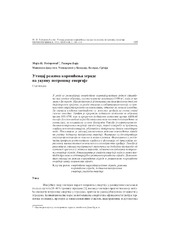Приказ основних података о документу
Uticaj režima korišćenja zgrade na ukupnu potrošnju energije
The influence of the building working regimes on total building energy consumption
| dc.creator | Todorović, Maja | |
| dc.creator | Bajc, Tamara | |
| dc.date.accessioned | 2022-09-19T16:51:23Z | |
| dc.date.available | 2022-09-19T16:51:23Z | |
| dc.date.issued | 2012 | |
| dc.identifier.issn | 0350-218X | |
| dc.identifier.uri | https://machinery.mas.bg.ac.rs/handle/123456789/1407 | |
| dc.description.abstract | U radu se razmatraju energetske karakteristike jednog stambeno-poslovnog objekta, ukupne korisne površine 1300 m2, koji se nalazi u Beogradu. Projektovan je jednocevni sistem toplovodnog radijatorskog grejanja, sa razdelnicima i sabirnicima na koji su priključeni strujni krugovi za svaki stan, odnosno za lokale posebno. Za sistem hlađenja predviđeni su lokalni uređaji za svaki stan/lokal posebno. Urađen je proračun gubitaka toplote za objekat prema DIN 4701, kao i proračun dobitaka toplote prema ASHRAE transfer function method koji obuhvata analizu časovnog opterećenja za svaki sat, za klimatske uslove Beograda. Takođe je izračunata godišnja potrošnja energije zgrade koja, pored potrebe za grejanjem, hlađenjem i ventilacijom, obuhvata i potrošnju tople sanitarne vode. Posmatran je uticaj različitih režima korišćenja zgrade na ukupnu godišnju potrošnju energije. Varirane su temperature unutar prostorija za zimski i letnji režim. Formirani su različiti profili rada sistema hlađenja u funkciji od prisustva korisnika, instalisanog osvetljenja i električnih uređaja. Takođe je razmatran uticaj unutrašnjeg zasenčenja na dobitke toplote od sunčevog zračenja u letnjem periodu, odnosno na godišnju potrošnju energije zgrade. Analizirana je ušteda energije koja se može postići primenom odgovarajućih režima korišćenja zgrade. Dominantan uticaj na režim korišćenja zgrade i racionalno korišćenje energije imaju korisnici zgrade. | sr |
| dc.description.abstract | The energy performances of one residential-business building of the total usable area of 1300m2, located in Belgrade, are analyzed. The one-pipe hot-water radiator system is designed in the building, with splitters and manifolds which are designed for each apartment and each commercial property separately. Cooling system is designed as local system for each apartment and commercial property separately. Heat losses for building are calculated according to DIN 4701. Heat gains are calculated according to ASHRAE transfer function method for load gains, which includes hourly energy simulation techniques for the energy consumption analysis for Belgrade weather data. Annual energy consumption of the building, including heating, cooling, ventilation, and hot water preparation is calculated. The influence of different modes of use of the building to the total annual energy consumption is considered. The temperatures inside the rooms are varied for winter and summer conditions. The different schedules for cooling regime are considered, as a function of the presence of the user, installed lighting and electrical equipment. The influence of the internal shading to the heat gains from solar radiation in summer and also on the annual energy consumption of the building is taken into account. The energy savings that can be achieved using appropriate modes of use of the building is analyzed. Users of the building have a great influence on the building working regime and on rational use of energy. | en |
| dc.publisher | Univerzitet u Beogradu - Institut za nuklearne nauke Vinča, Beograd i Društvo termičara Srbije, Beograd | |
| dc.relation | info:eu-repo/grantAgreement/MESTD/Technological Development (TD or TR)/33047/RS// | |
| dc.rights | openAccess | |
| dc.source | Termotehnika | |
| dc.subject | ušteda energije | sr |
| dc.subject | režimi korišćenja zgrade | sr |
| dc.subject | godišnja potrošnja energije | sr |
| dc.subject | energetske karakteristike zgrade | sr |
| dc.subject | mode of use of the building | en |
| dc.subject | energy saving | en |
| dc.subject | energy performance of the building | en |
| dc.subject | annual energy consumption | en |
| dc.title | Uticaj režima korišćenja zgrade na ukupnu potrošnju energije | sr |
| dc.title | The influence of the building working regimes on total building energy consumption | en |
| dc.type | article | |
| dc.rights.license | ARR | |
| dc.citation.epage | 119 | |
| dc.citation.issue | 2 | |
| dc.citation.other | 38(2): 109-119 | |
| dc.citation.rank | M51 | |
| dc.citation.spage | 109 | |
| dc.citation.volume | 38 | |
| dc.identifier.fulltext | http://machinery.mas.bg.ac.rs/bitstream/id/325/1404.pdf | |
| dc.identifier.rcub | https://hdl.handle.net/21.15107/rcub_machinery_1407 | |
| dc.type.version | publishedVersion |


